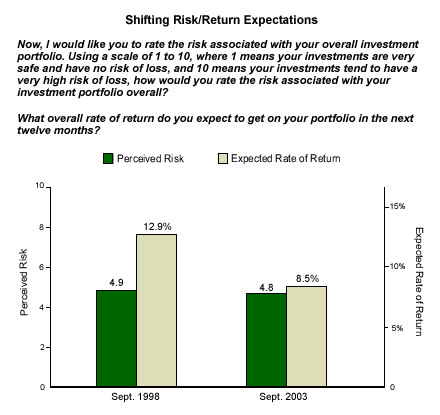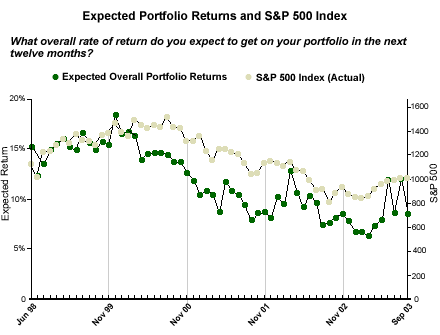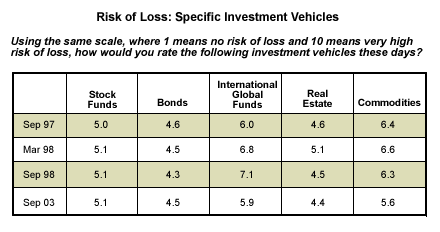Economic realities can change dramatically in five years, and investor risk-return expectations are no exception. As a part of the September 2003 UBS/Gallup Index of Investor Optimism survey*, Gallup asked investors about the risk exposure of their current investment portfolios. In comparing the risk-return expectations of investors from the current survey to those of investors in September 1998, it appears that investor risk-return expectations have shifted considerably.
Same Levels of Portfolio Risk, Lower Return
Survey respondents rated the risk of their investments on a scale of 1 to 10, with 1 indicating that their investments are very safe with no risk of loss, and 10 indicating their investments tend to have a very high risk of loss. In September 1998, the average risk investors assigned to their overall portfolios was 4.9. As of September 2003, the average investor's perception of risk exposure remains almost the same at 4.8.
However, corresponding investor expectations for their investment returns have substantially decreased. Average expectations for overall investment returns in the next 12 months have decreased from 12.9% in September 1998 to 8.5% in September 2003.
Thus, when comparing September 1998's numbers to this September's numbers, investors' average expectations for investment returns have decreased by 34%, even as their perceptions of risk to their portfolios have remained almost the same.

Reality Check: From Russian Debt Crisis to Jobless Recovery
Interestingly, the S&P 500 was trading at close to the same levels in September 1998 as it is today. With the Russian debt crisis and the subsequent collapse of the Long-Term Capital Management hedge fund, September 1998 was an uncertain time for the markets, as treasuries rallied with a flow of funds from equities to bonds in a flight to safety.
Despite the 2001 recession and subsequent crawl toward recovery, return expectations in June and August of this year (about 12%) were similar to those of September 1998. However, current uncertainties have brought investor expectations even lower this month, as implications of a long-term structural deficit and the "jobless" recovery have translated to lower expected returns by investors. In fact, expectations have fallen from a peak of 18.4% in December 1999 to 8.5% today.

Time to Invest in Commodities?
The current survey also reflects a shift in perceived risk with regard to different investment vehicles. The decline in the perceived risk of international funds, from 7.1 in September 1998 to 5.9 today, can be explained by the international contagion effects of the Russian financial crisis in 1998. It is more remarkable that commodities seem to be staging a comeback in the eyes of investors, as risk ratings have fallen from 6.3 in September 1998 to 5.6 in September 2003.

Bottom Line
While investors' optimism about their prospects has been volatile this year, overall their expectations for investment returns have continued a long-term decline since 1998. While that steady drop may seem discouraging to many observers, it can also be taken as a sign that investors are slowly coming out of a long denial following the bursting of the dot-com bubble, and bringing their return expectations in line with the reality of the markets.
*Results for the Index of Investor Optimism -- U.S. are based on telephone interviews with a randomly selected U.S. sample of 812 investors, aged 18 and older, with at least $10,000 of investable assets, conducted Sept. 1-14, 2003. For results based on these samples, one can say with 95% confidence that the maximum error attributable to sampling and other random effects is ±4 percentage points. In addition to sampling error, question wording and practical difficulties in conducting surveys can introduce error or bias into the findings of public opinion polls.

